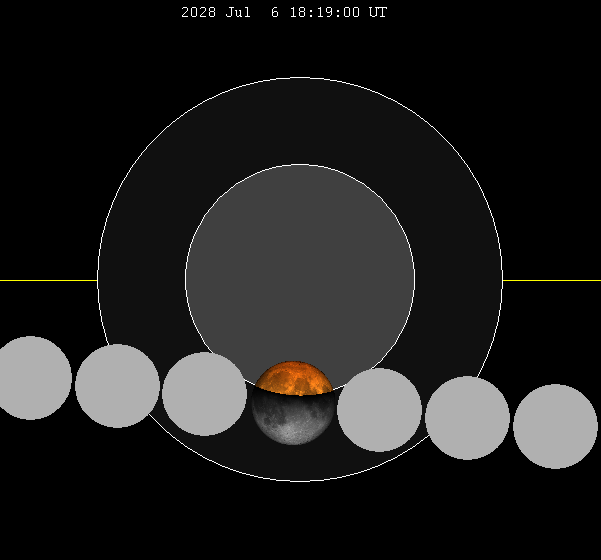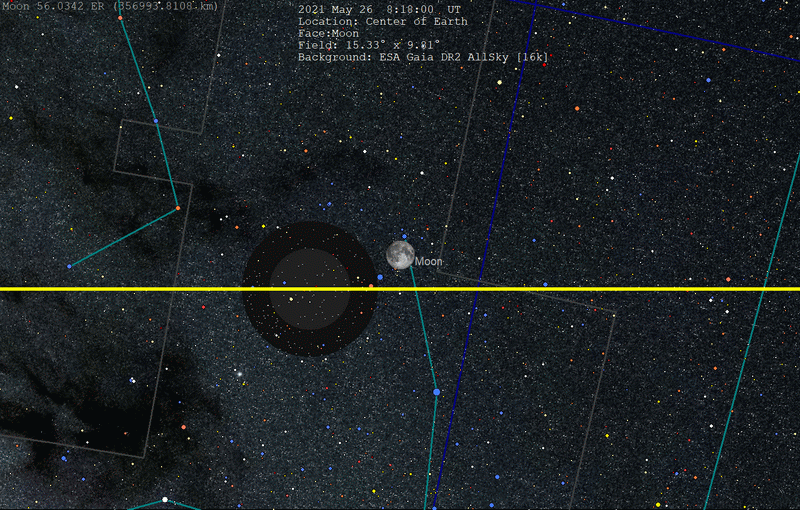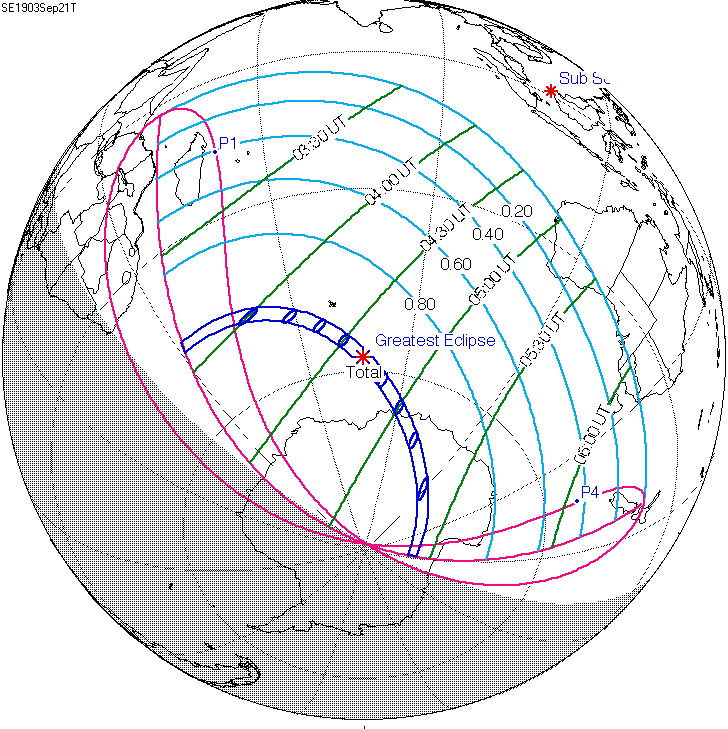|
July 2028 Lunar Eclipse
A partial lunar eclipse will take place on Thursday, July 6, 2028. Visibility It will be completely visible over much of Asia, Australia, and eastern Africa, and will be seen rising over the rest of Africa and eastern Europe. Related lunar eclipses Eclipses in 2028 * A partial lunar eclipse on Wednesday, 12 January 2028. * An annular solar eclipse on Wednesday, 26 January 2028. * A partial lunar eclipse on Thursday, 6 July 2028. * A total solar eclipse on Saturday, 22 July 2028. * A total lunar eclipse on Sunday, 31 December 2028. Lunar year series Half-Saros cycle A lunar eclipse will be preceded and followed by solar eclipses by 9 years and 5.5 days (a half saros).Mathematical Astronomy Morsels, Jean Meeus, p.110, Chapter 18, ''The half-saros'' This lunar eclipse is related to two total solar eclipses of Solar Saros 127. Tzolkinex * Preceded: Lunar eclipse of May 26, 2021 * Followed: Lunar eclipse of August 19, 2035 See also *List of lunar eclipses and List o ... [...More Info...] [...Related Items...] OR: [Wikipedia] [Google] [Baidu] |
Lunar Eclipse Chart Close-2028Jul06
Lunar most commonly means "of or relating to the Moon". Lunar may also refer to: Arts and entertainment * ''Lunar'' (series), a series of video games * "Lunar" (song), by David Guetta * "Lunar", a song by Priestess from the 2009 album '' Prior to the Fire'' * Lunars, a fictional race in the series '' The Lunar Chronicles'' by Marissa Meyer Other uses * Lunar Magic, Super Mario World level editor * Lunar Design, or LUNAR, a San Francisco-based design consultancy * Hasselblad Lunar, a digital camera * Lunar, a brandname of Ethinylestradiol/cyproterone acetate, a birth control pill * Lunar C (Jake Brook, born 1990), English rapper See also * * * Lunar calendar, based upon the monthly cycles of the Moon's phase ** Lunar day, in such calendars ** Lunar month, in such calendars * Moon (other) The Moon is Earth's only natural satellite. Moon may also refer to: Celestial bodies * Natural satellite or Moon (generic) *Moon, a Chinese asterism corresponding to 37 ... [...More Info...] [...Related Items...] OR: [Wikipedia] [Google] [Baidu] |
Solar Saros 127
Saros cycle The saros () is a period of exactly 223 synodic months, approximately 6585.3211 days, or 18 years, 10, 11, or 12 days (depending on the number of leap years), and 8 hours, that can be used to predict eclipses of the Sun and Moon. One saros period ... series 127 for solar eclipses occurs at the Moon's ascending node, repeating every 18 years, 11 days, containing 82 events. All eclipses in this series occurs at the Moon's ascending node. This solar saros is linked to Lunar Saros 120. Umbral eclipses Umbral eclipses (annular, total and hybrid) can be further classified as either: 1) Central (two limits), 2) Central (one limit) or 3) Non-Central (one limit). The statistical distribution of these classes in Saros series 127 appears in the following table. Events References * http://eclipse.gsfc.nasa.gov/SEsaros/SEsaros127.html External linksSaros cycle 127 - Information and visualization {{Solar eclipses Solar saros series ... [...More Info...] [...Related Items...] OR: [Wikipedia] [Google] [Baidu] |
21st-century Lunar Eclipses
The 1st century was the century spanning AD 1 ( I) through AD 100 ( C) according to the Julian calendar. It is often written as the or to distinguish it from the 1st century BC (or BCE) which preceded it. The 1st century is considered part of the Classical era, epoch, or historical period. The 1st century also saw the appearance of Christianity. During this period, Europe, North Africa and the Near East fell under increasing domination by the Roman Empire, which continued expanding, most notably conquering Britain under the emperor Claudius (AD 43). The reforms introduced by Augustus during his long reign stabilized the empire after the turmoil of the previous century's civil wars. Later in the century the Julio-Claudian dynasty, which had been founded by Augustus, came to an end with the suicide of Nero in AD 68. There followed the famous Year of Four Emperors, a brief period of civil war and instability, which was finally brought to an end by Vespasian, ninth Roman emperor, a ... [...More Info...] [...Related Items...] OR: [Wikipedia] [Google] [Baidu] |
List Of 21st-century Lunar Eclipses
There will be 230 lunar eclipses in the 21st century (2001–2100): 87 penumbral, 58 partial and 85 total. Eclipses are listed in sets by lunar years, repeating every 12 months for each node. Ascending node eclipses are given a red background highlight. See also: List of lunar eclipses, List of 20th-century lunar eclipses, and List of 22nd-century lunar eclipses List of lunar eclipses between 1998 and 2100 Eclipses from August 1998 are included to complete the first eclipse set. References This list was compiled with data calculated by Fred Espenak of NASA's GSFC. {{DEFAULTSORT:21st-Century Lunar Eclipses * Lunar eclipses Lunar eclipses A lunar eclipse occurs when the Moon moves into the Earth's shadow. Such alignment occurs during an eclipse season, approximately every six months, during the full moon phase, when the Moon's orbital plane is closest to the plane of the Earth ... 21 Science timelines Lunar eclipses by time ... [...More Info...] [...Related Items...] OR: [Wikipedia] [Google] [Baidu] |
List Of Lunar Eclipses
There are several lists of lunar eclipses On the Moon, by the Earth ; Type * List of central lunar eclipses * Total penumbral lunar eclipse ; Classification * List of saros series for lunar eclipses * Tetrad (astronomy) contains lists of tetrads in the late-20th and 21st centuries ; By era * Lunar eclipses by century * Historically significant lunar eclipses Historically significant lunar eclipses are eclipses of the Moon that are mentioned in historical accounts in connection with a significant event. Lunar eclipses are somewhat rare events, although not as rare as solar eclipses, because unlike sol ... On Earth, by the Moon {{DEFAULTSORT:Lunar eclipses ... [...More Info...] [...Related Items...] OR: [Wikipedia] [Google] [Baidu] |
August 2035 Lunar Eclipse
A partial lunar eclipse A lunar eclipse occurs when the Moon moves into the Earth's shadow. Such alignment occurs during an eclipse season, approximately every six months, during the full moon phase, when the Moon's orbital plane is closest to the plane of the Earth ... will take place on August 19, 2035. Visibility Related lunar eclipses Lunar year series Tzolkinex * Preceded: Lunar eclipse of July 6, 2028 * Followed: Lunar eclipse of September 29, 2042 See also * List of lunar eclipses and List of 21st-century lunar eclipses Notes External links * 2035-08 2035-08 2035 in science {{lunar-eclipse-stub ... [...More Info...] [...Related Items...] OR: [Wikipedia] [Google] [Baidu] |
May 2021 Lunar Eclipse
A total lunar eclipse occurred on 26 May 2021. A lunar eclipse occurs when the Moon moves into the Earth's shadow. This can occur only when the Sun, Earth, and Moon are exactly or very closely aligned (in syzygy) with Earth between the other two, which can only happen at a full moon. The eclipsed moon appeared as a faint red disk in the sky due to a small amount of light being refracted through the earth's atmosphere; this appearance gives a lunar eclipse its nickname of a Blood Moon. It was the first total lunar eclipse since the January 2019 lunar eclipse, and the first in a series of an ''almost tetrad'' (with four consecutive total or deep partial lunar eclipses). The next total eclipse occurred in May 2022. The event took place near lunar perigee; as a result, this supermoon was referred to in US media coverage as a "super flower blood moon", and elsewhere as a "super blood moon". It was followed two weeks later by an annular solar eclipse on 10 June 2021 over the n ... [...More Info...] [...Related Items...] OR: [Wikipedia] [Google] [Baidu] |
SE2037Jul13T
SE, Se, or Sé may refer to: Arts and entertainment * ''Sé'' (album), by Lúnasa, 2006 * Se (instrument), a traditional Chinese musical instrument Businesses and organizations * Sea Ltd (NYSE: SE), tech conglomerate headquartered in Singapore * Slovenské elektrárne, electric utility company in Slovakia * Societas Europaea, a European Union public company * XL Airways France, IATA airline designator SE * Southeastern (train operating company), or SE Trains Limited, in England Places * Sè, Atlantique, Benin * Sè, Mono, Benin *Subprefecture of Sé, São Paulo, Brazil **Sé (district of São Paulo) **Sé (São Paulo Metro), a station *Sé, Hungary *Sé, Macau *Sé (Angra do Heroísmo), Terceira, Azores, Portugal *Sé (Braga), Portugal *Sé (Bragança), Faro, Portugal *Sé (Funchal), Madeira, Portugal *Sé, Lamego, Portugal *Sé (Lisbon), Portugal *Sé, Portalegre, Portugal *Sé (Porto), Portugal * SE postcode area, London, England * Sergipe (SE), a state of Brazil * Sweden, I ... [...More Info...] [...Related Items...] OR: [Wikipedia] [Google] [Baidu] |
SE2019Jul02T
SE, Se, or Sé may refer to: Arts and entertainment * ''Sé'' (album), by Lúnasa, 2006 * Se (instrument), a traditional Chinese musical instrument Businesses and organizations * Sea Ltd (NYSE: SE), tech conglomerate headquartered in Singapore * Slovenské elektrárne, electric utility company in Slovakia * Societas Europaea, a European Union public company * XL Airways France, IATA airline designator SE * Southeastern (train operating company), or SE Trains Limited, in England Places * Sè, Atlantique, Benin * Sè, Mono, Benin * Subprefecture of Sé, São Paulo, Brazil **Sé (district of São Paulo) **Sé (São Paulo Metro), a station * Sé, Hungary *Sé, Macau * Sé (Angra do Heroísmo), Terceira, Azores, Portugal *Sé (Braga), Portugal *Sé (Bragança), Faro, Portugal *Sé (Funchal), Madeira, Portugal *Sé, Lamego, Portugal * Sé (Lisbon), Portugal *Sé, Portalegre, Portugal *Sé (Porto), Portugal * SE postcode area, London, England * Sergipe (SE), a state of Brazil * S ... [...More Info...] [...Related Items...] OR: [Wikipedia] [Google] [Baidu] |
Solar Eclipse Of July 13, 2037
A total solar eclipse will occur on July 13, 2037. A solar eclipse occurs when the Moon passes between Earth and the Sun, thereby totally or partly obscuring the image of the Sun for a viewer on Earth. A total solar eclipse occurs when the Moon's apparent diameter is larger than the Sun's, blocking all direct sunlight, turning day into darkness. Totality occurs in a narrow path across Earth's surface, with the partial solar eclipse visible over a surrounding region thousands of kilometres wide. Totality will pass through the centre of Brisbane Brisbane ( ) is the capital and most populous city of the states and territories of Australia, Australian state of Queensland, and the list of cities in Australia by population, third-most populous city in Australia and Oceania, with a populati ... and the Gold Coast. Images Animated path Related eclipses 2036–2039 Saros 127 Metonic series All eclipses in this table occur at the Moon's ascending node. References ... [...More Info...] [...Related Items...] OR: [Wikipedia] [Google] [Baidu] |
Solar Eclipse Of July 2, 2019
A total solar eclipse occurred at the ascending node of the Moon's orbit on Tuesday, July 2, 2019, with an eclipse magnitude of 1.0459. Totality was visible from the southern Pacific Ocean east of New Zealand to the Coquimbo Region in Chile and Central Argentina at sunset, with the maximum of 4 minutes 33 seconds visible from the Pacific Ocean. The Moon was only 2.4 days before perigee (Perigee on July 5, 2019), making it fairly large. Another solar eclipse occurred one lunar year after this eclipse, on June 21, 2020. A total solar eclipse crossed this region of the Earth on December 14, 2020. Images Visibility A solar eclipse occurs when the Moon passes between Earth and the Sun, thereby totally or partly obscuring the image of the Sun for a viewer on Earth. A total solar eclipse occurs when the Moon's apparent diameter is larger than the Sun's, blocking all direct sunlight, turning day into darkness. Totality occurs in a narrow path across Earth's surface, with the partial ... [...More Info...] [...Related Items...] OR: [Wikipedia] [Google] [Baidu] |
Saros (astronomy)
The saros () is a period of exactly 223 synodic months, approximately 6585.3211 days, or 18 years, 10, 11, or 12 days (depending on the number of leap years), and 8 hours, that can be used to predict eclipses of the Sun and Moon. One saros period after an eclipse, the Sun, Earth, and Moon return to approximately the same relative geometry, a near straight line, and a nearly identical eclipse will occur, in what is referred to as an eclipse cycle. A sar is one half of a saros. A series of eclipses that are separated by one saros is called a ''saros series''. It corresponds to: *6,585.321347 solar days *18.029 years *223 synodic months *241.999 draconic months *18.999 eclipse years (38 eclipse seasons) *238.992 anomalistic months The 19 eclipse years means that if there is a solar eclipse (or lunar eclipse), then after one saros a new moon will take place at the same node of the orbit of the Moon, and under these circumstances another eclipse can occur. History The earliest disco ... [...More Info...] [...Related Items...] OR: [Wikipedia] [Google] [Baidu] |







